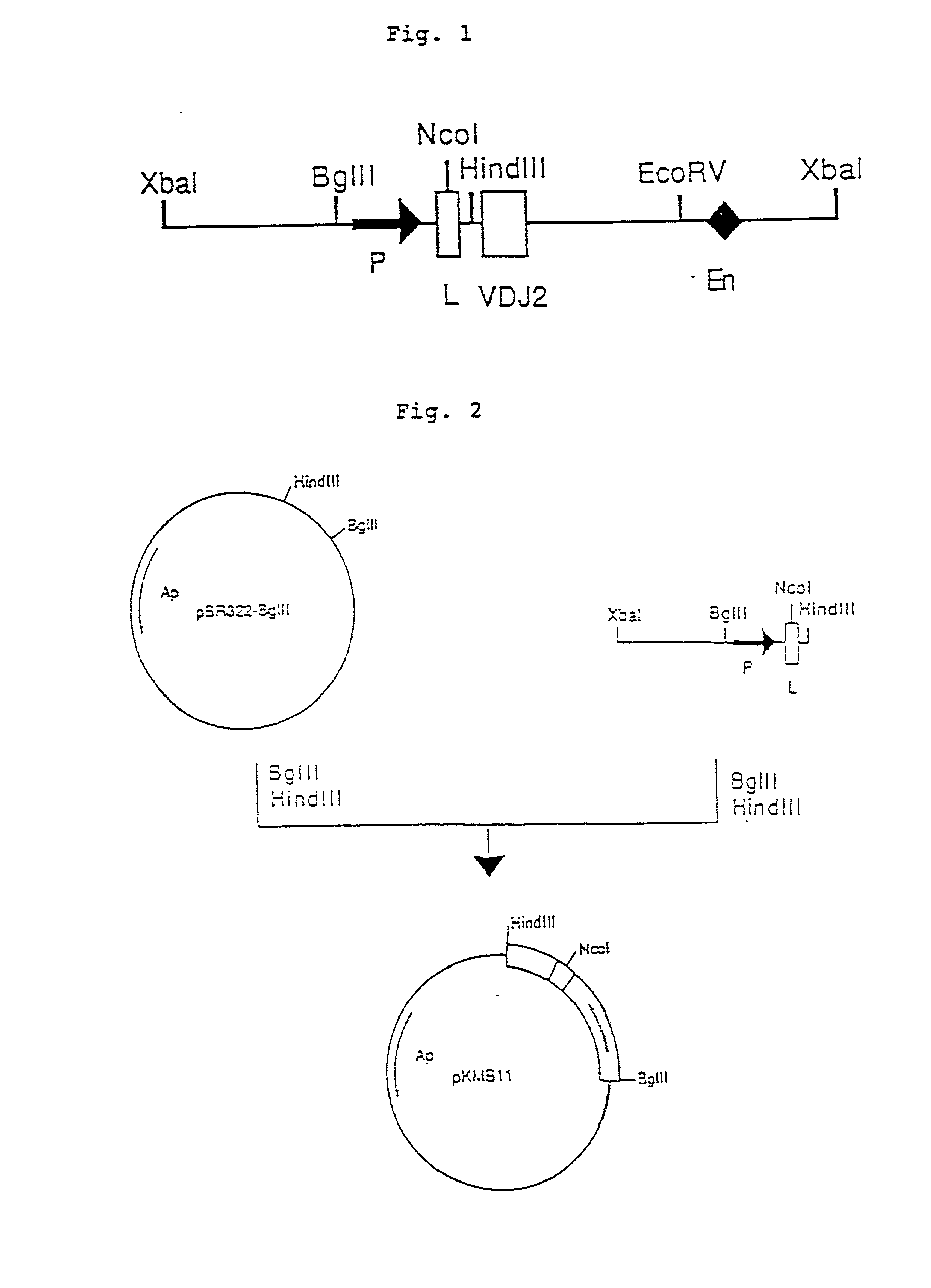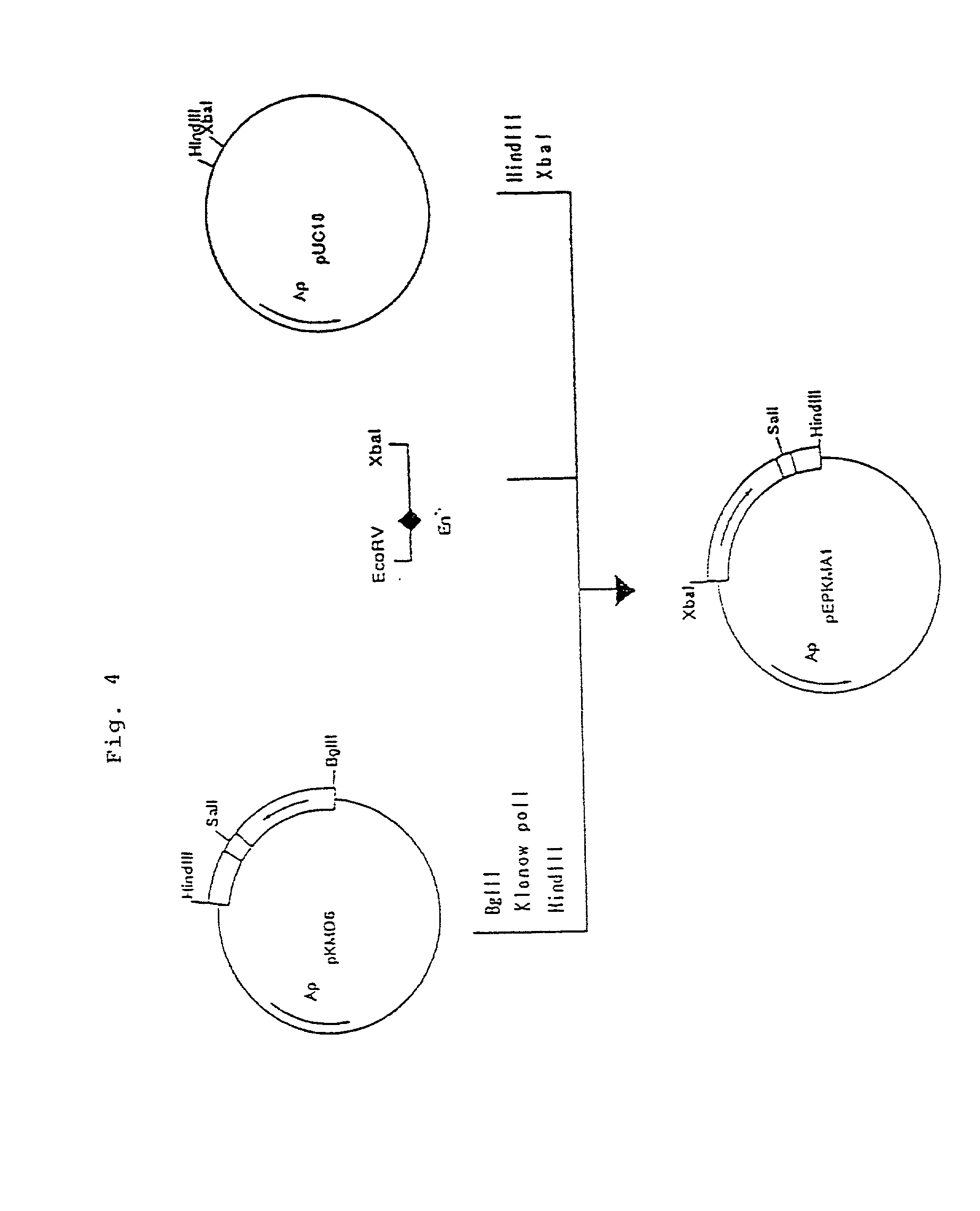Process for producing humanized chimera antibody
- Summary
- Abstract
- Description
- Claims
- Application Information
AI Technical Summary
Benefits of technology
Problems solved by technology
Method used
Image
Examples
example 2
[0164] Anti-GD.sub.3 chimera antibody
[0165] 1. Preparation of mRNA from a hybridoma cell line capable of producing mouse anti-GD.sub.3 monoclonal antibody KM-641
[0166] Using a mRNA extraction kit, Fast Track (No. K1593-02, available from Invitrogen), 34 .mu.g of mRNA was prepared from 1.times.10.sup.8 cells of a hybridoma cell line which is capable of producing mouse anti-GD.sub.3 monoclonal antibody KM-641 prepared by the method described later in Reference Example shown below.
[0167] 2. Preparation of cDNA libraries of KM-641 H chain and L chain genes
[0168] Using ZAP-cDNA Synthesis Kit (No. sc200400), a cDNA synthesis kit available from Stratagene Cloning Systems, cDNA having EcoRI adaptor on its 5'-end and XhoI adaptor on its 3'-end was prepared from 3 .mu.g of the mRNA obtained in the above procedure 1. About 6 .mu.g of the cDNA was dissolved in 10 .mu.l of sterile water and subjected to agarose gel electrophoresis to recover 0.1 .mu.g of an H chain-corresponding cDNA fragment of...
reference example 1
[0231] (1) Preparation of antigen
[0232] In 30 ml of chloroform / methanol (2 / 1) solution were dissolved 5 .mu.g of ganglioside GD.sub.3 having NeaAc.alpha.2.fwdarw.8NeuAc.alpha.2.-fwdarw.3Gal sugar chain on its non-reducing end (Iatron), 0.5 .mu.mol of dipalmitoylphosphatidylcholine (Sigma Chemical Co.), 0.5 .mu.mol of cholesterol (Nakalai Tesque), 0.05 .mu.mol of dipalmitoylphosphatidylic acid (Sigma Chemical Co.) and 2.5 .mu.g of Lipid A (Funakoshi Pharmaceutical Co., Ltd.). The thus prepared solution was warmed at 45.degree. C. to remove solvents, thereby obtaining a uniform lipid thin film. After completely removing solvents by sacking the film for 1 hour using a vacuum pump, the resulting film was mixed with 0.5 ml of PBS solution and stirred at 45.degree. C. to obtain an antigen solution.
[0233] (2) Preparation of antibody-producing cells
[0234] Mice was immunized by administering 0.5 ml of the antigen solution obtained in the above step (1) into the caudal vein once every week fo...
PUM
| Property | Measurement | Unit |
|---|---|---|
| Length | aaaaa | aaaaa |
| Length | aaaaa | aaaaa |
| Density | aaaaa | aaaaa |
Abstract
Description
Claims
Application Information
 Login to View More
Login to View More - R&D
- Intellectual Property
- Life Sciences
- Materials
- Tech Scout
- Unparalleled Data Quality
- Higher Quality Content
- 60% Fewer Hallucinations
Browse by: Latest US Patents, China's latest patents, Technical Efficacy Thesaurus, Application Domain, Technology Topic, Popular Technical Reports.
© 2025 PatSnap. All rights reserved.Legal|Privacy policy|Modern Slavery Act Transparency Statement|Sitemap|About US| Contact US: help@patsnap.com



